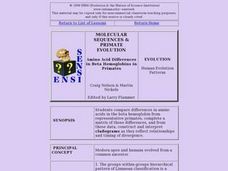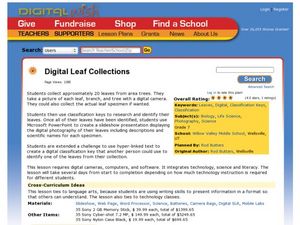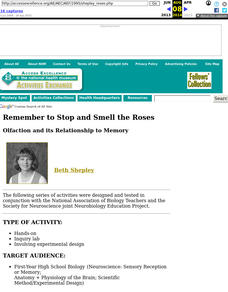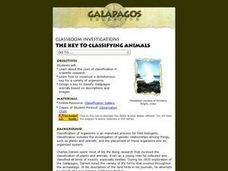Curated OER
Stellaluna
First graders discuss the strategy of asking yourself questions while reading. in this Stellaluna lesson plan, 1st graders write questions on a chart about the story. Students turn and talk after reading chunks of text. Students see...
Curated OER
Forests of the Sea
Students read about and conduct experiments to learn about the vegetation under Monterey Bay. In this Monterey Bay lesson, students read about and look at brightly colored pictures of the different types of seaweed that grows in the bay....
Curated OER
Structures and Behaviors of Planarians
Students investigate planaria of the phylum platyhelminthes. They use DigiScope technology to observe and describe the structure and movements of planarians.
Curated OER
My Tree Book
Students "adopt" a tree and throughout the year record and examine its characteristics and the changes that it goes through.
Curated OER
Vector Voyage!
Students use vector analysis to examine the concept of dead reckoning. They listen to a teacher-led lecture, complete a Vector Voyage Worksheet with the teacher, answer discussion questions, and use the Pythagorean Theorem for speed...
Curated OER
Lightning in a Jar
Students create lightning with two common objects and observe the colorful "discharge" of electrons on a smaller scale. By exploring the phenomena of static electricity, students relate their knowledge to the real-life weather phenomena...
Curated OER
PRIMATE CLASSIFICATION: Evolution, Cladograms,
Students transfer examples (names) of primates from their location in an outline hierarchy of primate groups into a set of nested boxes reflecting that same hierarchy. A cladogram can then be drawn illustrating how these groups are...
Curated OER
Molecular Sequences & Primate Evolution: Amino Acids, Hemoglobins in Evolution
Young scholars compare differences in amino acids in the beta hemoglobin from representative primates, complete a matrix of those differences, and from these data, construct and interpret cladograms as they reflect relationships and...
Curated OER
THE INCREDIBLE JOURNEY
Students describe the movement of water within the water cycle and identify the states of water as it moves through the water cycle.
Curated OER
Classroom Cladogram of Vertebrate/Human Evolution
Students build a Colossal Classroom Cladogram of vertebrate evolution. After putting it together, they show the gradual, mosaic accumulation of the traits which we, as humans, possess.
Curated OER
Exterior Ballistics
Students explore velocity and trajectory. Using exterior ballistics rules, students predetermine the path of an artillery shell. Given equations and the firing angle, students determine the velocity and horizontal travel. Students...
Curated OER
Take Deep Breath
Fifth graders become familiar with how the diaphragm expands to draw air into our lungs and contracts to exhale carbon dioxide. They also label the major parts of the respiratory system through the use of interactive Internet research...
Curated OER
Mapping The Ocean Floor
Young scholars explore and analyze the bottom structure of underwater habitats. They describe and explain what can't see through the collection and correlation of accurate data. Learners assess that technology is utilized as a tool for...
Curated OER
Go to the Source- Your Town's Tap Water
Students investigate their town's tap water. In this water quality lesson, students complete a simple taste-testing experiment and online research to investigate tap water.
Curated OER
Digital Leaf collections
Seventh graders collect and classify leaves. In this digital leaf collection lesson, 7th graders photograph approximately 20 leaves. Students use their leaves in a multimedia presentation and create hyperlinks to identify the...
Curated OER
Wild About Wildfires
Students conduct a debate. In this wildfire and controlled burning lesson plan, students watch the video "Legacy of Fire" and discuss the topic of wildland fires and controlled burns. Half of the class researches the arguments for...
Curated OER
Parts of a Tree
Students identify four parts of trees. In this plant biology lesson, students read the book Trees and conduct Internet research to identify the parts of the tree. Students take notes from each website and complete an included worksheet.
Curated OER
Remember to Stop and Smell the Roses: Olfaction and its Relationship to Memory
Students discover that olfaction elicits memory associations. They investigate how olfaction compares to other sensory modalities in the formation of memories. This is a hands-on lab activity guaranteed to build memories in your students!
Curated OER
Clipbirds
Students attempt to pick up various objects with a wide variety of beaks, including scissors, spoons, etc.
Curated OER
How to Make a Model of the Human Respiratory System
Students label parts of the human respiratory system on a diagram. They explain the function of diaphragm.
Curated OER
The Key To Classifying Animals
Explorers of the environment construct a dichotomous key for a variety of organisms and design a key to classify Galapagos animals based on descriptions and images. The lesson includes a link to an animal gallery and the worksheet for...
Curated OER
Forest Activity: Leaf Collection and Creating a Herbarium
Students identify and categorize leaves. They collect leaves from trees, research the leaves using field guides and the Internet, press, label, and display the leaves, and discuss how the leaf reflects adaptation to its environment.
Curated OER
A Little Horse Sense
How have horses evolved over time? How do horse skulls reveal this evolution? How have the roles horses play changed over time? What kind of social structure do horse herds have? How should wild horse populations be managed? To find the...
Curated OER
Deep Sea Coral Biodiversity
Students research life forms of both tropical coral reefs and deep-sea coral reefs to discover the biodiversity of the ecosystems. They compare and contrast the diversity and adaptations of the two eco-systems, and draw a picture showing...
Other popular searches
- Major Branches of Science
- Biological Sciences Branches
- The Branches of Science
- 20 Branches of Science
- 12 Branches of Science
- Three Branches of Science
- All Branches of Science
- Earth Science Branches
- Biological Science Branches
- Science Branches

























